Imperial College of Australia SITHCCC007: Prepare Stocks, Sauces
VerifiedAdded on 2023/06/18
|7
|2190
|160
Homework Assignment
AI Summary
This SITHCCC007 assignment solution from The Imperial College of Australia provides detailed answers to questions related to preparing stocks, sauces, and soups. The assignment covers selecting ingredients, preparing and using equipment, portioning and preparing ingredients, preparing different types of stocks, sauces, and soups, and finally, presenting and storing them safely. Topics include understanding recipe requirements, mise en place tasks, quality factors for selecting ingredients, safe equipment operation, precision cuts, clarification techniques, thickening agents, and food safety during reheating and storage. The document also provides information on adjusting flavor and consistency, appropriate garnishes, and storage temperatures to optimize shelf life and comply with food safety standards.
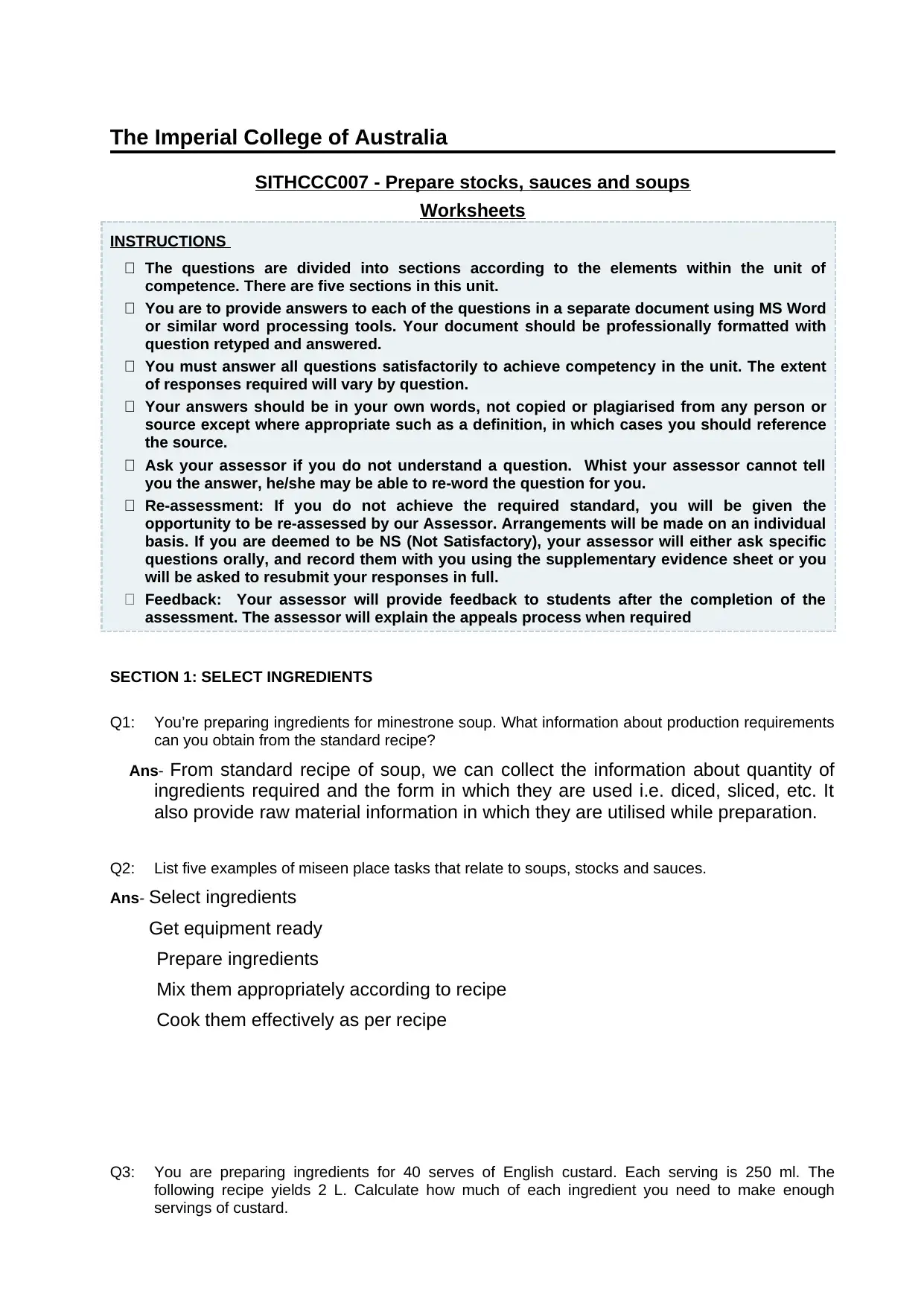
The Imperial College of Australia
SITHCCC007 - Prepare stocks, sauces and soups
Worksheets
INSTRUCTIONS
The questions are divided into sections according to the elements within the unit of
competence. There are five sections in this unit.
You are to provide answers to each of the questions in a separate document using MS Word
or similar word processing tools. Your document should be professionally formatted with
question retyped and answered.
You must answer all questions satisfactorily to achieve competency in the unit. The extent
of responses required will vary by question.
Your answers should be in your own words, not copied or plagiarised from any person or
source except where appropriate such as a definition, in which cases you should reference
the source.
Ask your assessor if you do not understand a question. Whist your assessor cannot tell
you the answer, he/she may be able to re-word the question for you.
Re-assessment: If you do not achieve the required standard, you will be given the
opportunity to be re-assessed by our Assessor. Arrangements will be made on an individual
basis. If you are deemed to be NS (Not Satisfactory), your assessor will either ask specific
questions orally, and record them with you using the supplementary evidence sheet or you
will be asked to resubmit your responses in full.
Feedback: Your assessor will provide feedback to students after the completion of the
assessment. The assessor will explain the appeals process when required
SECTION 1: SELECT INGREDIENTS
Q1: You’re preparing ingredients for minestrone soup. What information about production requirements
can you obtain from the standard recipe?
Ans- From standard recipe of soup, we can collect the information about quantity of
ingredients required and the form in which they are used i.e. diced, sliced, etc. It
also provide raw material information in which they are utilised while preparation.
Q2: List five examples of miseen place tasks that relate to soups, stocks and sauces.
Ans- Select ingredients
Get equipment ready
Prepare ingredients
Mix them appropriately according to recipe
Cook them effectively as per recipe
Q3: You are preparing ingredients for 40 serves of English custard. Each serving is 250 ml. The
following recipe yields 2 L. Calculate how much of each ingredient you need to make enough
servings of custard.
SITHCCC007 - Prepare stocks, sauces and soups
Worksheets
INSTRUCTIONS
The questions are divided into sections according to the elements within the unit of
competence. There are five sections in this unit.
You are to provide answers to each of the questions in a separate document using MS Word
or similar word processing tools. Your document should be professionally formatted with
question retyped and answered.
You must answer all questions satisfactorily to achieve competency in the unit. The extent
of responses required will vary by question.
Your answers should be in your own words, not copied or plagiarised from any person or
source except where appropriate such as a definition, in which cases you should reference
the source.
Ask your assessor if you do not understand a question. Whist your assessor cannot tell
you the answer, he/she may be able to re-word the question for you.
Re-assessment: If you do not achieve the required standard, you will be given the
opportunity to be re-assessed by our Assessor. Arrangements will be made on an individual
basis. If you are deemed to be NS (Not Satisfactory), your assessor will either ask specific
questions orally, and record them with you using the supplementary evidence sheet or you
will be asked to resubmit your responses in full.
Feedback: Your assessor will provide feedback to students after the completion of the
assessment. The assessor will explain the appeals process when required
SECTION 1: SELECT INGREDIENTS
Q1: You’re preparing ingredients for minestrone soup. What information about production requirements
can you obtain from the standard recipe?
Ans- From standard recipe of soup, we can collect the information about quantity of
ingredients required and the form in which they are used i.e. diced, sliced, etc. It
also provide raw material information in which they are utilised while preparation.
Q2: List five examples of miseen place tasks that relate to soups, stocks and sauces.
Ans- Select ingredients
Get equipment ready
Prepare ingredients
Mix them appropriately according to recipe
Cook them effectively as per recipe
Q3: You are preparing ingredients for 40 serves of English custard. Each serving is 250 ml. The
following recipe yields 2 L. Calculate how much of each ingredient you need to make enough
servings of custard.
Paraphrase This Document
Need a fresh take? Get an instant paraphrase of this document with our AI Paraphraser
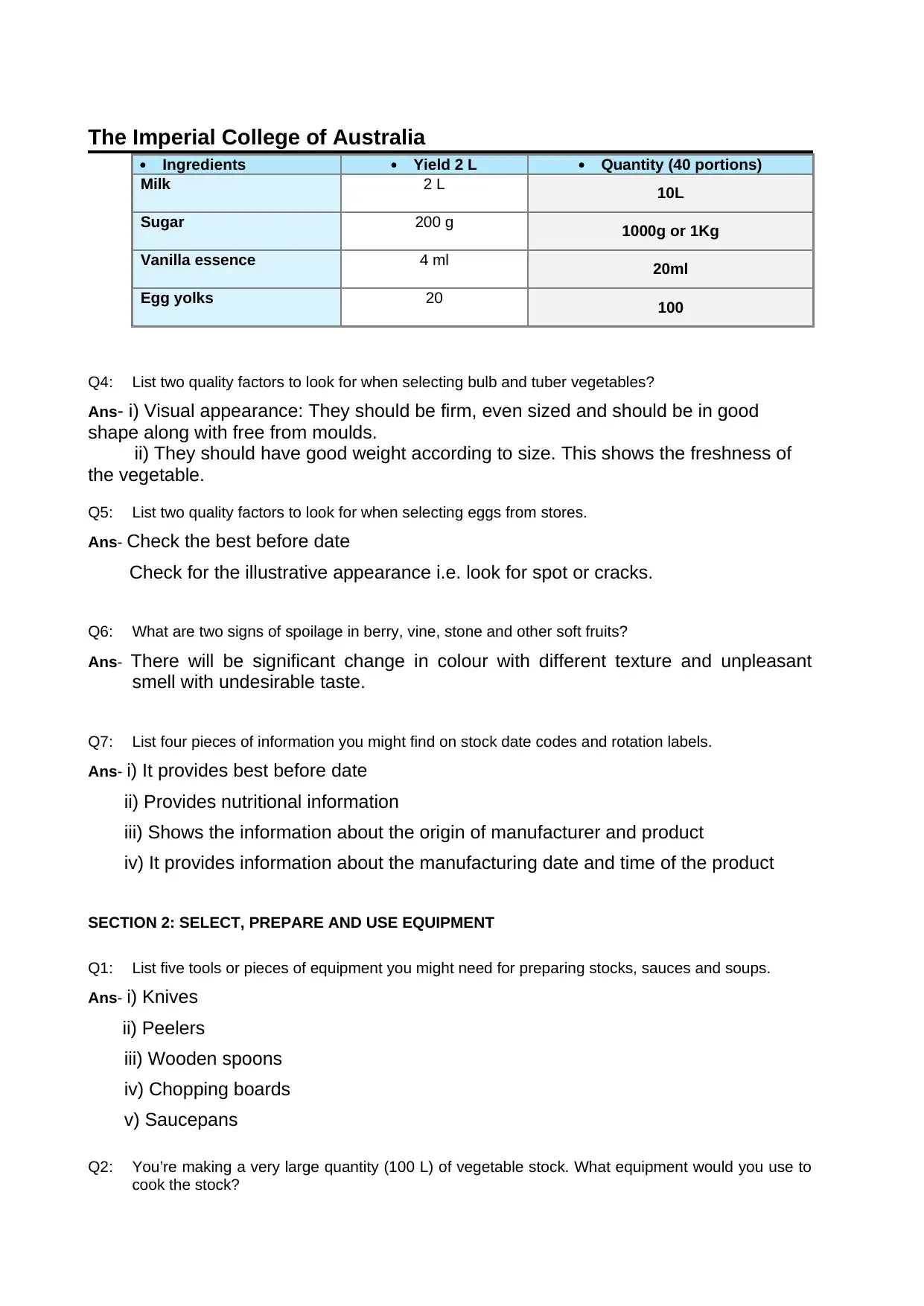
The Imperial College of Australia
Ingredients Yield 2 L Quantity (40 portions)
Milk 2 L 10L
Sugar 200 g 1000g or 1Kg
Vanilla essence 4 ml 20ml
Egg yolks 20 100
Q4: List two quality factors to look for when selecting bulb and tuber vegetables?
Ans- i) Visual appearance: They should be firm, even sized and should be in good
shape along with free from moulds.
ii) They should have good weight according to size. This shows the freshness of
the vegetable.
Q5: List two quality factors to look for when selecting eggs from stores.
Ans- Check the best before date
Check for the illustrative appearance i.e. look for spot or cracks.
Q6: What are two signs of spoilage in berry, vine, stone and other soft fruits?
Ans- There will be significant change in colour with different texture and unpleasant
smell with undesirable taste.
Q7: List four pieces of information you might find on stock date codes and rotation labels.
Ans- i) It provides best before date
ii) Provides nutritional information
iii) Shows the information about the origin of manufacturer and product
iv) It provides information about the manufacturing date and time of the product
SECTION 2: SELECT, PREPARE AND USE EQUIPMENT
Q1: List five tools or pieces of equipment you might need for preparing stocks, sauces and soups.
Ans- i) Knives
ii) Peelers
iii) Wooden spoons
iv) Chopping boards
v) Saucepans
Q2: You’re making a very large quantity (100 L) of vegetable stock. What equipment would you use to
cook the stock?
Ingredients Yield 2 L Quantity (40 portions)
Milk 2 L 10L
Sugar 200 g 1000g or 1Kg
Vanilla essence 4 ml 20ml
Egg yolks 20 100
Q4: List two quality factors to look for when selecting bulb and tuber vegetables?
Ans- i) Visual appearance: They should be firm, even sized and should be in good
shape along with free from moulds.
ii) They should have good weight according to size. This shows the freshness of
the vegetable.
Q5: List two quality factors to look for when selecting eggs from stores.
Ans- Check the best before date
Check for the illustrative appearance i.e. look for spot or cracks.
Q6: What are two signs of spoilage in berry, vine, stone and other soft fruits?
Ans- There will be significant change in colour with different texture and unpleasant
smell with undesirable taste.
Q7: List four pieces of information you might find on stock date codes and rotation labels.
Ans- i) It provides best before date
ii) Provides nutritional information
iii) Shows the information about the origin of manufacturer and product
iv) It provides information about the manufacturing date and time of the product
SECTION 2: SELECT, PREPARE AND USE EQUIPMENT
Q1: List five tools or pieces of equipment you might need for preparing stocks, sauces and soups.
Ans- i) Knives
ii) Peelers
iii) Wooden spoons
iv) Chopping boards
v) Saucepans
Q2: You’re making a very large quantity (100 L) of vegetable stock. What equipment would you use to
cook the stock?
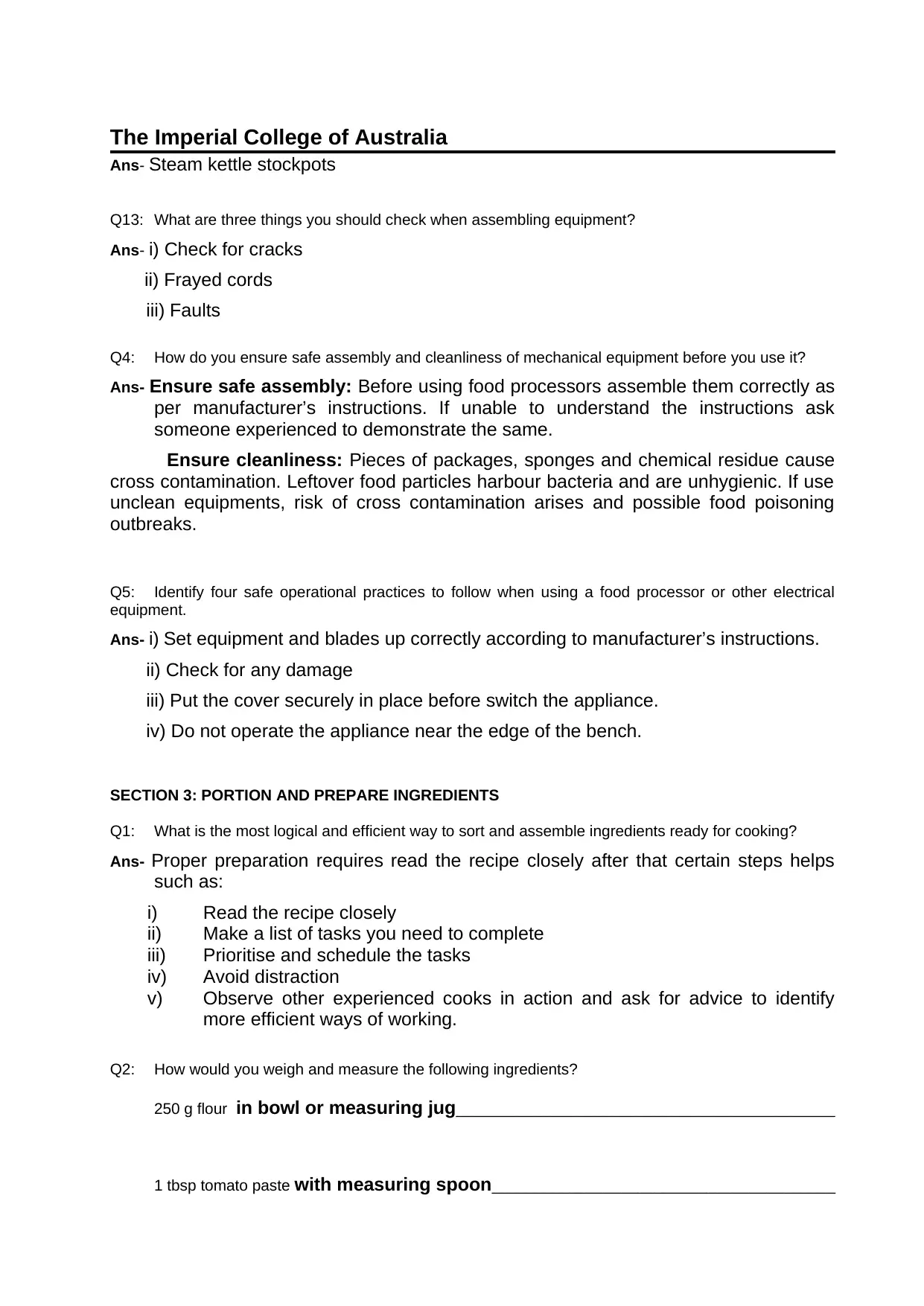
The Imperial College of Australia
Ans- Steam kettle stockpots
Q13: What are three things you should check when assembling equipment?
Ans- i) Check for cracks
ii) Frayed cords
iii) Faults
Q4: How do you ensure safe assembly and cleanliness of mechanical equipment before you use it?
Ans- Ensure safe assembly: Before using food processors assemble them correctly as
per manufacturer’s instructions. If unable to understand the instructions ask
someone experienced to demonstrate the same.
Ensure cleanliness: Pieces of packages, sponges and chemical residue cause
cross contamination. Leftover food particles harbour bacteria and are unhygienic. If use
unclean equipments, risk of cross contamination arises and possible food poisoning
outbreaks.
Q5: Identify four safe operational practices to follow when using a food processor or other electrical
equipment.
Ans- i) Set equipment and blades up correctly according to manufacturer’s instructions.
ii) Check for any damage
iii) Put the cover securely in place before switch the appliance.
iv) Do not operate the appliance near the edge of the bench.
SECTION 3: PORTION AND PREPARE INGREDIENTS
Q1: What is the most logical and efficient way to sort and assemble ingredients ready for cooking?
Ans- Proper preparation requires read the recipe closely after that certain steps helps
such as:
i) Read the recipe closely
ii) Make a list of tasks you need to complete
iii) Prioritise and schedule the tasks
iv) Avoid distraction
v) Observe other experienced cooks in action and ask for advice to identify
more efficient ways of working.
Q2: How would you weigh and measure the following ingredients?
250 g flour in bowl or measuring jug____________________________________________
1 tbsp tomato paste with measuring spoon________________________________________
Ans- Steam kettle stockpots
Q13: What are three things you should check when assembling equipment?
Ans- i) Check for cracks
ii) Frayed cords
iii) Faults
Q4: How do you ensure safe assembly and cleanliness of mechanical equipment before you use it?
Ans- Ensure safe assembly: Before using food processors assemble them correctly as
per manufacturer’s instructions. If unable to understand the instructions ask
someone experienced to demonstrate the same.
Ensure cleanliness: Pieces of packages, sponges and chemical residue cause
cross contamination. Leftover food particles harbour bacteria and are unhygienic. If use
unclean equipments, risk of cross contamination arises and possible food poisoning
outbreaks.
Q5: Identify four safe operational practices to follow when using a food processor or other electrical
equipment.
Ans- i) Set equipment and blades up correctly according to manufacturer’s instructions.
ii) Check for any damage
iii) Put the cover securely in place before switch the appliance.
iv) Do not operate the appliance near the edge of the bench.
SECTION 3: PORTION AND PREPARE INGREDIENTS
Q1: What is the most logical and efficient way to sort and assemble ingredients ready for cooking?
Ans- Proper preparation requires read the recipe closely after that certain steps helps
such as:
i) Read the recipe closely
ii) Make a list of tasks you need to complete
iii) Prioritise and schedule the tasks
iv) Avoid distraction
v) Observe other experienced cooks in action and ask for advice to identify
more efficient ways of working.
Q2: How would you weigh and measure the following ingredients?
250 g flour in bowl or measuring jug____________________________________________
1 tbsp tomato paste with measuring spoon________________________________________
⊘ This is a preview!⊘
Do you want full access?
Subscribe today to unlock all pages.

Trusted by 1+ million students worldwide
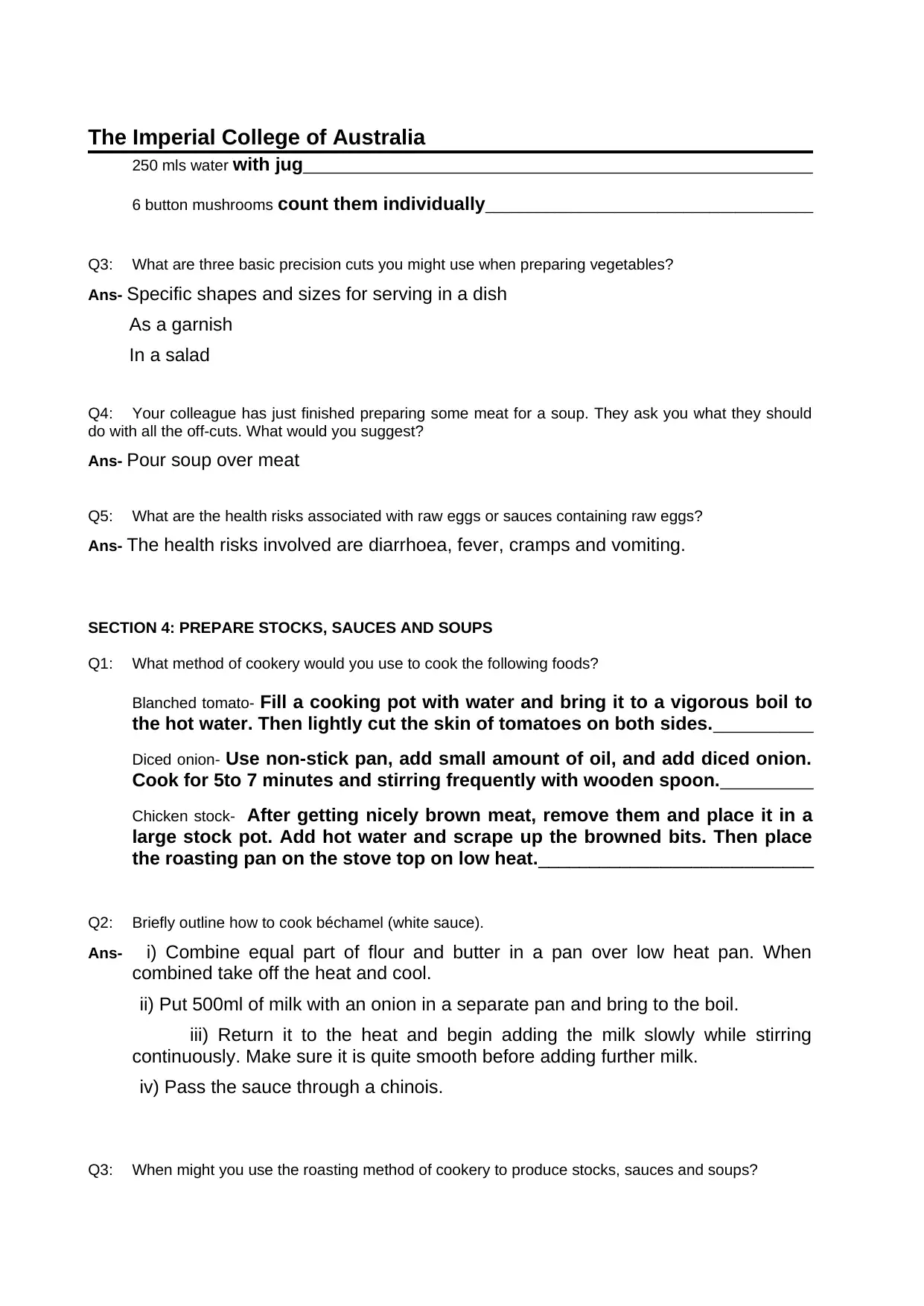
The Imperial College of Australia
250 mls water with jug___________________________________________________________
6 button mushrooms count them individually______________________________________
Q3: What are three basic precision cuts you might use when preparing vegetables?
Ans- Specific shapes and sizes for serving in a dish
As a garnish
In a salad
Q4: Your colleague has just finished preparing some meat for a soup. They ask you what they should
do with all the off-cuts. What would you suggest?
Ans- Pour soup over meat
Q5: What are the health risks associated with raw eggs or sauces containing raw eggs?
Ans- The health risks involved are diarrhoea, fever, cramps and vomiting.
SECTION 4: PREPARE STOCKS, SAUCES AND SOUPS
Q1: What method of cookery would you use to cook the following foods?
Blanched tomato- Fill a cooking pot with water and bring it to a vigorous boil to
the hot water. Then lightly cut the skin of tomatoes on both sides.____________
Diced onion- Use non-stick pan, add small amount of oil, and add diced onion.
Cook for 5to 7 minutes and stirring frequently with wooden spoon.___________
Chicken stock- After getting nicely brown meat, remove them and place it in a
large stock pot. Add hot water and scrape up the browned bits. Then place
the roasting pan on the stove top on low heat.___________________________
Q2: Briefly outline how to cook béchamel (white sauce).
Ans- i) Combine equal part of flour and butter in a pan over low heat pan. When
combined take off the heat and cool.
ii) Put 500ml of milk with an onion in a separate pan and bring to the boil.
iii) Return it to the heat and begin adding the milk slowly while stirring
continuously. Make sure it is quite smooth before adding further milk.
iv) Pass the sauce through a chinois.
Q3: When might you use the roasting method of cookery to produce stocks, sauces and soups?
250 mls water with jug___________________________________________________________
6 button mushrooms count them individually______________________________________
Q3: What are three basic precision cuts you might use when preparing vegetables?
Ans- Specific shapes and sizes for serving in a dish
As a garnish
In a salad
Q4: Your colleague has just finished preparing some meat for a soup. They ask you what they should
do with all the off-cuts. What would you suggest?
Ans- Pour soup over meat
Q5: What are the health risks associated with raw eggs or sauces containing raw eggs?
Ans- The health risks involved are diarrhoea, fever, cramps and vomiting.
SECTION 4: PREPARE STOCKS, SAUCES AND SOUPS
Q1: What method of cookery would you use to cook the following foods?
Blanched tomato- Fill a cooking pot with water and bring it to a vigorous boil to
the hot water. Then lightly cut the skin of tomatoes on both sides.____________
Diced onion- Use non-stick pan, add small amount of oil, and add diced onion.
Cook for 5to 7 minutes and stirring frequently with wooden spoon.___________
Chicken stock- After getting nicely brown meat, remove them and place it in a
large stock pot. Add hot water and scrape up the browned bits. Then place
the roasting pan on the stove top on low heat.___________________________
Q2: Briefly outline how to cook béchamel (white sauce).
Ans- i) Combine equal part of flour and butter in a pan over low heat pan. When
combined take off the heat and cool.
ii) Put 500ml of milk with an onion in a separate pan and bring to the boil.
iii) Return it to the heat and begin adding the milk slowly while stirring
continuously. Make sure it is quite smooth before adding further milk.
iv) Pass the sauce through a chinois.
Q3: When might you use the roasting method of cookery to produce stocks, sauces and soups?
Paraphrase This Document
Need a fresh take? Get an instant paraphrase of this document with our AI Paraphraser

The Imperial College of Australia
Ans- When someone wants to defat bones and vegetables for stocks, sauces and
soups. It helps to develop a fond, the caramelized drippings that stick to the bottom of
the pan which enhances the flavour.
Q4: Explain how each of these clarifying agents is important to clarifying consommé.
Lean minced meat – It contributes additional flavour and gelatine to liquid.
Another importance is that it is best source of protein that help
clarifying.
Egg whites- This provides additional clarifying power. It helps to give
additional strength to the protein in the meat.
Mirepoix of vegetables- Provides additional flavour to the finished soups.
Q5: How do you use a ‘bouquet garni’ to flavour soups and stocks?
Ans- Put the bouquet garni into sachet. Tie it closed with a long piece of string. Tie the
other end to the pot. Remove it when obtain desired flavour.
Q6: What happens to stock if you use too much tomato paste?
Ans- It makes the stock very cloudy
Q7: Which sauces have brown meat stock with red wine in them?
Ans- Cocktail, Tartare, Vert, Hollandaise, Bolognaise, Cream soups, chicken stock
Q8: Which stock is most likely to have lemon juice added to it?
Ans- Fish stock which are used as poaching liquids.
Q9: Identify the base sauce and additional ingredients necessary to make the following derivations.
Remoulade sauce- It consists of mayonnaise with Cajun seasoning, whole grain
mustard hot sauce and grated fresh horseradish.
Mornay sauce- Features a base of flour milk, egg and butter along with mixture of
parmesan and gruyere produces thick and velvety white cheese sauce.
Bercy sauce- It contains fish stock, veloute sauce, white wine, shallots and butter.
Q10: Provide an appropriate thickening agent for each of the following sauces and soups.
Ans- When someone wants to defat bones and vegetables for stocks, sauces and
soups. It helps to develop a fond, the caramelized drippings that stick to the bottom of
the pan which enhances the flavour.
Q4: Explain how each of these clarifying agents is important to clarifying consommé.
Lean minced meat – It contributes additional flavour and gelatine to liquid.
Another importance is that it is best source of protein that help
clarifying.
Egg whites- This provides additional clarifying power. It helps to give
additional strength to the protein in the meat.
Mirepoix of vegetables- Provides additional flavour to the finished soups.
Q5: How do you use a ‘bouquet garni’ to flavour soups and stocks?
Ans- Put the bouquet garni into sachet. Tie it closed with a long piece of string. Tie the
other end to the pot. Remove it when obtain desired flavour.
Q6: What happens to stock if you use too much tomato paste?
Ans- It makes the stock very cloudy
Q7: Which sauces have brown meat stock with red wine in them?
Ans- Cocktail, Tartare, Vert, Hollandaise, Bolognaise, Cream soups, chicken stock
Q8: Which stock is most likely to have lemon juice added to it?
Ans- Fish stock which are used as poaching liquids.
Q9: Identify the base sauce and additional ingredients necessary to make the following derivations.
Remoulade sauce- It consists of mayonnaise with Cajun seasoning, whole grain
mustard hot sauce and grated fresh horseradish.
Mornay sauce- Features a base of flour milk, egg and butter along with mixture of
parmesan and gruyere produces thick and velvety white cheese sauce.
Bercy sauce- It contains fish stock, veloute sauce, white wine, shallots and butter.
Q10: Provide an appropriate thickening agent for each of the following sauces and soups.
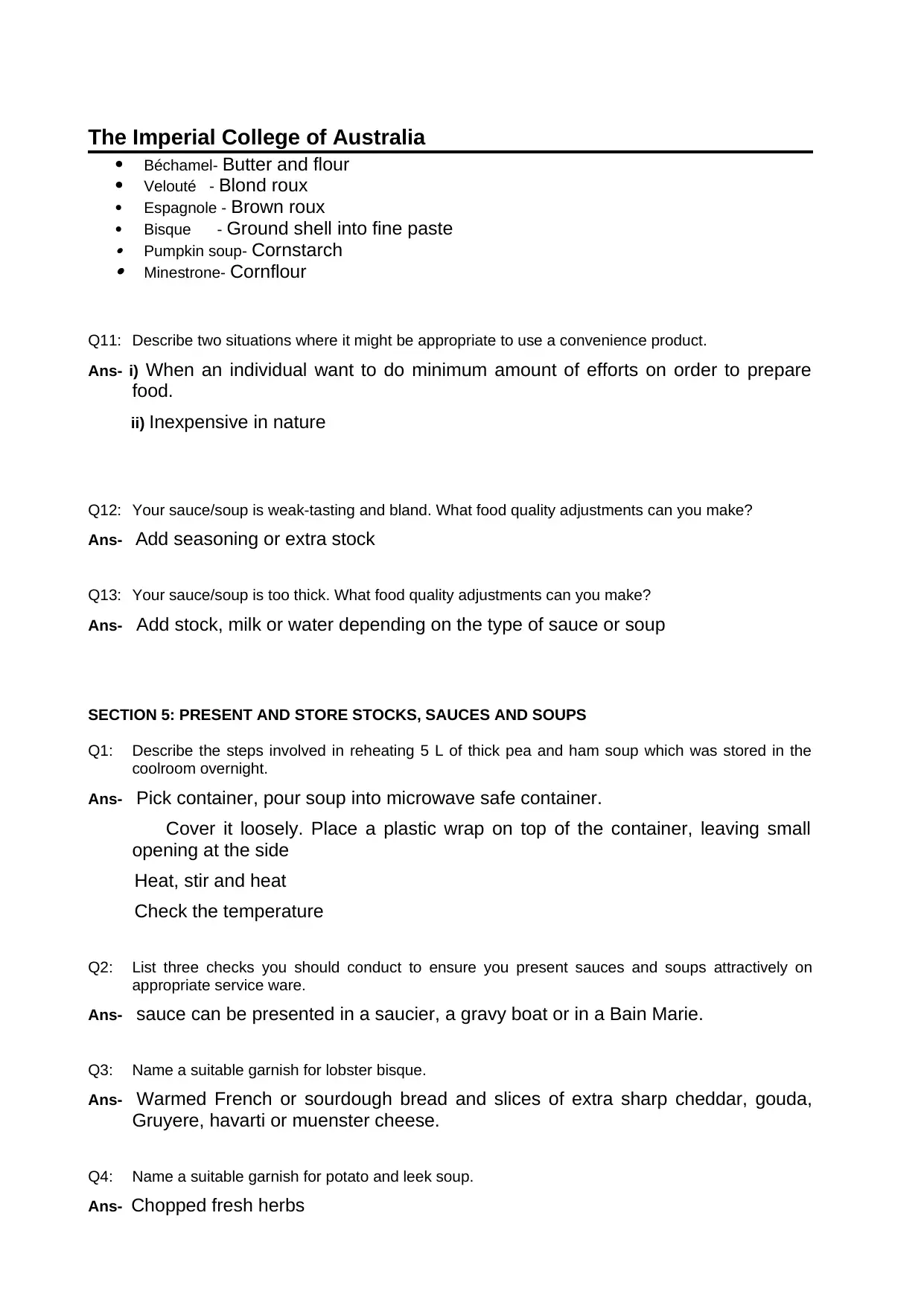
The Imperial College of Australia
Béchamel- Butter and flour
Velouté - Blond roux
Espagnole - Brown roux
Bisque - Ground shell into fine paste
Pumpkin soup- Cornstarch
Minestrone- Cornflour
Q11: Describe two situations where it might be appropriate to use a convenience product.
Ans- i) When an individual want to do minimum amount of efforts on order to prepare
food.
ii) Inexpensive in nature
Q12: Your sauce/soup is weak-tasting and bland. What food quality adjustments can you make?
Ans- Add seasoning or extra stock
Q13: Your sauce/soup is too thick. What food quality adjustments can you make?
Ans- Add stock, milk or water depending on the type of sauce or soup
SECTION 5: PRESENT AND STORE STOCKS, SAUCES AND SOUPS
Q1: Describe the steps involved in reheating 5 L of thick pea and ham soup which was stored in the
coolroom overnight.
Ans- Pick container, pour soup into microwave safe container.
Cover it loosely. Place a plastic wrap on top of the container, leaving small
opening at the side
Heat, stir and heat
Check the temperature
Q2: List three checks you should conduct to ensure you present sauces and soups attractively on
appropriate service ware.
Ans- sauce can be presented in a saucier, a gravy boat or in a Bain Marie.
Q3: Name a suitable garnish for lobster bisque.
Ans- Warmed French or sourdough bread and slices of extra sharp cheddar, gouda,
Gruyere, havarti or muenster cheese.
Q4: Name a suitable garnish for potato and leek soup.
Ans- Chopped fresh herbs
Béchamel- Butter and flour
Velouté - Blond roux
Espagnole - Brown roux
Bisque - Ground shell into fine paste
Pumpkin soup- Cornstarch
Minestrone- Cornflour
Q11: Describe two situations where it might be appropriate to use a convenience product.
Ans- i) When an individual want to do minimum amount of efforts on order to prepare
food.
ii) Inexpensive in nature
Q12: Your sauce/soup is weak-tasting and bland. What food quality adjustments can you make?
Ans- Add seasoning or extra stock
Q13: Your sauce/soup is too thick. What food quality adjustments can you make?
Ans- Add stock, milk or water depending on the type of sauce or soup
SECTION 5: PRESENT AND STORE STOCKS, SAUCES AND SOUPS
Q1: Describe the steps involved in reheating 5 L of thick pea and ham soup which was stored in the
coolroom overnight.
Ans- Pick container, pour soup into microwave safe container.
Cover it loosely. Place a plastic wrap on top of the container, leaving small
opening at the side
Heat, stir and heat
Check the temperature
Q2: List three checks you should conduct to ensure you present sauces and soups attractively on
appropriate service ware.
Ans- sauce can be presented in a saucier, a gravy boat or in a Bain Marie.
Q3: Name a suitable garnish for lobster bisque.
Ans- Warmed French or sourdough bread and slices of extra sharp cheddar, gouda,
Gruyere, havarti or muenster cheese.
Q4: Name a suitable garnish for potato and leek soup.
Ans- Chopped fresh herbs
⊘ This is a preview!⊘
Do you want full access?
Subscribe today to unlock all pages.

Trusted by 1+ million students worldwide
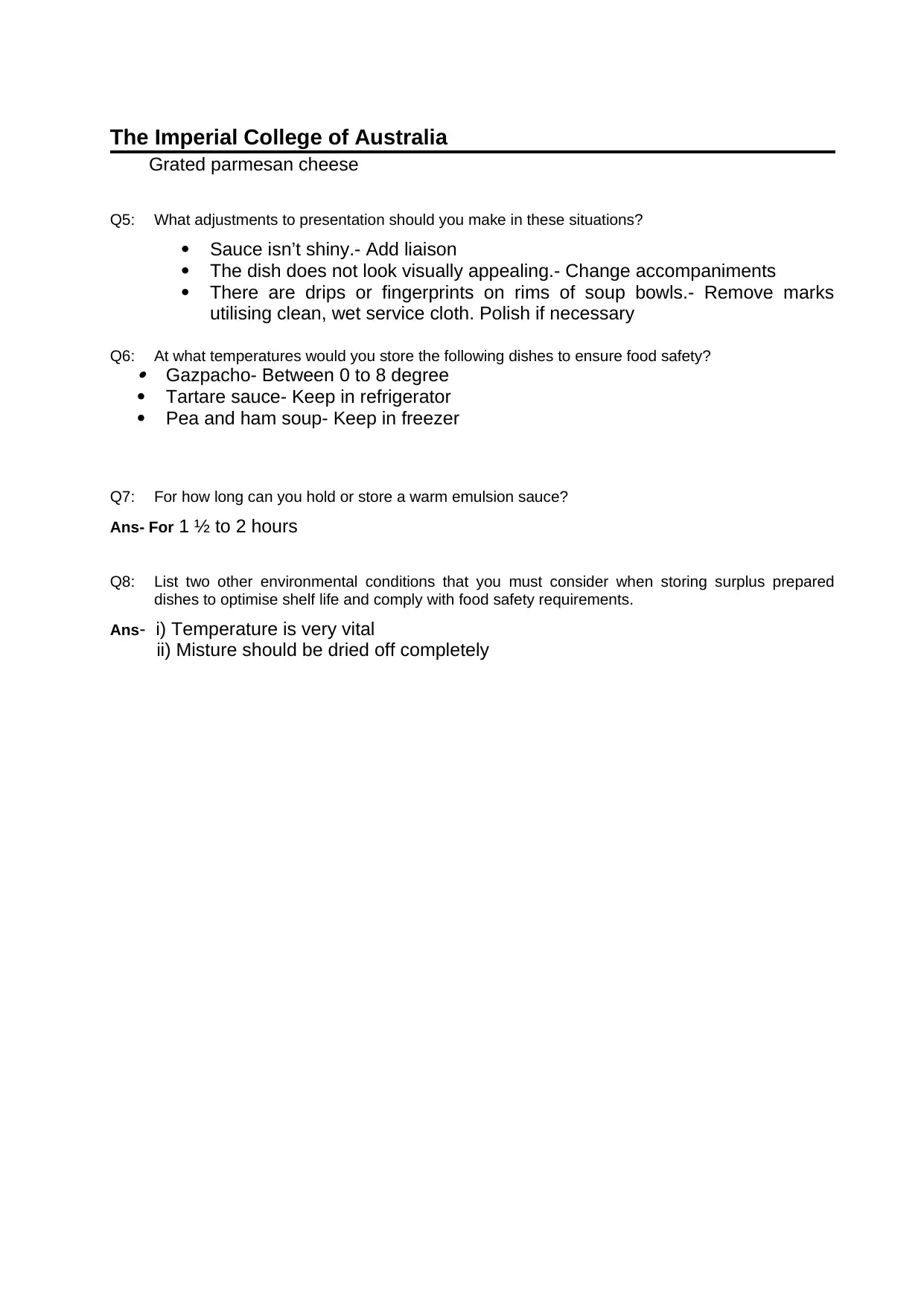
The Imperial College of Australia
Grated parmesan cheese
Q5: What adjustments to presentation should you make in these situations?
Sauce isn’t shiny.- Add liaison
The dish does not look visually appealing.- Change accompaniments
There are drips or fingerprints on rims of soup bowls.- Remove marks
utilising clean, wet service cloth. Polish if necessary
Q6: At what temperatures would you store the following dishes to ensure food safety?
Gazpacho- Between 0 to 8 degree
Tartare sauce- Keep in refrigerator
Pea and ham soup- Keep in freezer
Q7: For how long can you hold or store a warm emulsion sauce?
Ans- For 1 ½ to 2 hours
Q8: List two other environmental conditions that you must consider when storing surplus prepared
dishes to optimise shelf life and comply with food safety requirements.
Ans- i) Temperature is very vital
ii) Misture should be dried off completely
Grated parmesan cheese
Q5: What adjustments to presentation should you make in these situations?
Sauce isn’t shiny.- Add liaison
The dish does not look visually appealing.- Change accompaniments
There are drips or fingerprints on rims of soup bowls.- Remove marks
utilising clean, wet service cloth. Polish if necessary
Q6: At what temperatures would you store the following dishes to ensure food safety?
Gazpacho- Between 0 to 8 degree
Tartare sauce- Keep in refrigerator
Pea and ham soup- Keep in freezer
Q7: For how long can you hold or store a warm emulsion sauce?
Ans- For 1 ½ to 2 hours
Q8: List two other environmental conditions that you must consider when storing surplus prepared
dishes to optimise shelf life and comply with food safety requirements.
Ans- i) Temperature is very vital
ii) Misture should be dried off completely
1 out of 7
Related Documents
Your All-in-One AI-Powered Toolkit for Academic Success.
+13062052269
info@desklib.com
Available 24*7 on WhatsApp / Email
![[object Object]](/_next/static/media/star-bottom.7253800d.svg)
Unlock your academic potential
Copyright © 2020–2026 A2Z Services. All Rights Reserved. Developed and managed by ZUCOL.





